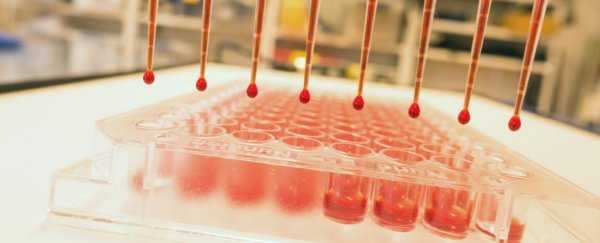Blood test for early diagnosis of cancer with ... sound waves
Recently, scientists have developed a new way to test blood by sound waves. This invention promises to be a much faster, simpler, more accurate and faster mobile test kit than the devices currently in use.
These tests focus on exosome - the 'small packets' that are released by the cell, which transport information to all parts of the body, including information about illness. If we can stop the transport of these news packages, we can learn a lot about the health of the body.
According to the researchers, the current testing methods such as high-speed centrifugation or chemical cell tagging, may damage blood samples on transit. But this will not happen with the newly developed blood test technology, the international team of researchers said.
One of the team members - Massachusetts Institute of Technology Ming Dao, said: " Sound waves with sound waves are very convenient because the sound waves are extremely light. When affected by force, molecular particles Sound only takes about a second or less to split, this is a great advantage. "

Find a new blood test.(Photo: Shutterstock).
This new blood test process is based on the research the team conducted in 2014 when they first separated cells by exposing cells to sound waves as they moved through a small groove.
The new device classifies cells with sound waves, including a micro-conduction channel in contact with two sound sensors that are tilted. When sound waves emitted by these sensors meet, they form standing waves that form a series of pressure nodes.
Every time a cell or particle moves through the microcirculation channel and touches a node, the cell-driven pressure moves away from the center. The cell travel distance depends on size and other properties such as compression, so it is possible to separate cells of different sizes as they move to the end of the microcirculation channel.
To separate the exosome, the researchers built a device with two consecutive components. First, sound waves are used to remove cells and platelets from blood samples. Subsequently, blood samples were introduced into the second unit using higher frequency sound waves to separate the exosome from larger extracellular vesicles. And it only takes nearly 25 minutes for this device to process an undiluted 100 microlit blood sample.
"These exosomes often contain specific molecules, which are signs of abnormalities taking place in the body. If we separate it from the blood, we can perform biological analyzes and see what's inside it , 'said researcher Ming Dao.
Previously, exosomes were once considered a sign of cancer, kidney problems and neurodegenerative diseases and numerous other health problems. So if we can get a new device to remove exosome from the body easily and quickly, this is indeed a great victory for researchers.
This method is less invasive than tissue biopsy and it is also very accurate. According to Tony Jun Huang, a member of Duke University research team, this new technique can solve the limitations of current blood testing technology in many areas, such as the difficulty of exosome and temporal separation. Long processing time, inconsistencies, low productivity, contamination, and incompleteness of exosome.
"We want to extract high quality exosome just by simply pressing a button and getting the desired samples within 10 minutes ," he added.

Exosome extract.(Photo: Research team).
The team is currently planning to apply this technology to identify biological indicators that show disease status. In addition, the scientists received funding from the National Institutes of Health to study signs related to the phenomenon of fetal malformations as well as diagnose other health problems.
"The amazing ability of this method is that it can separate nano-sized cell sacs that basically do not alter their biological properties or physical properties. Interesting possibilities to develop new methods for assessing human health as well as the onset and progression of disease, " said Subra Suresh, a researcher at Nanyang Technological University in Singapore.
- Tests help detect cancer early
- SoftBank and many other companies invest billions of money into cancer testing technology with blood
- A breakthrough in cancer diagnosis and treatment
- Early diagnosis of pancreatic cancer with a drop of blood
- Find out how to detect ovarian cancer early
- Blood tests can help detect lung cancer early
- Early detection of ovarian cancer thanks to regular blood tests
- Use nano sensors to diagnose cancer early
- Australia developed a method for rapid diagnosis of skin cancer
- Sound waves can lead drugs into the body to kill tumors
- New blood tests detect the type of cancer that haunts a gentleman
- New blood tests help detect 8 types of cancer
 Green tea cleans teeth better than mouthwash?
Green tea cleans teeth better than mouthwash? Death kiss: This is why you should not let anyone kiss your baby's lips
Death kiss: This is why you should not let anyone kiss your baby's lips What is salmonellosis?
What is salmonellosis? Caution should be exercised when using aloe vera through eating and drinking
Caution should be exercised when using aloe vera through eating and drinking NASA tests X-59 supersonic aircraft engine for the first time
NASA tests X-59 supersonic aircraft engine for the first time  China develops super powerful acoustic laser technology
China develops super powerful acoustic laser technology  How science hears the creepy sound of a black hole
How science hears the creepy sound of a black hole  If sound is as fast as the speed of light, what happens?
If sound is as fast as the speed of light, what happens?  Harvard successfully develops sound wave chip, compatible with quantum computers
Harvard successfully develops sound wave chip, compatible with quantum computers  Research shows: Sound has two different speeds on Mars
Research shows: Sound has two different speeds on Mars 